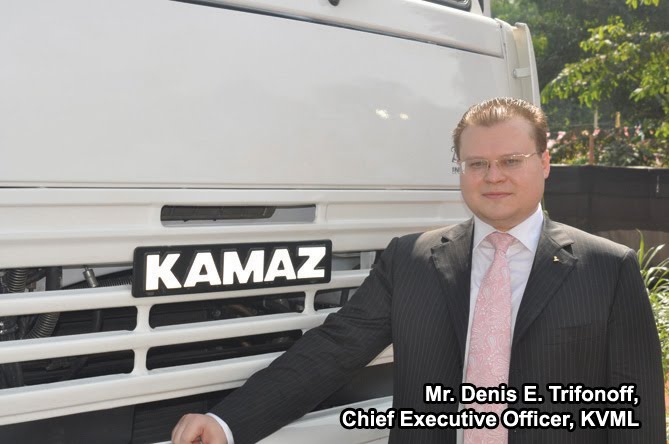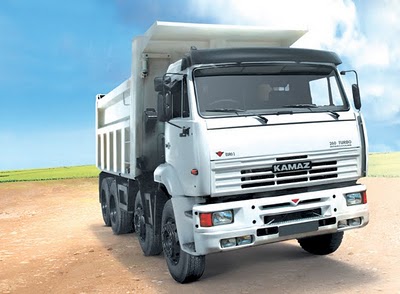 Of the many commercial vehicle manufacturers who’ve entered India in the recent past, Russian Truck major Kamaz looks to be a more serious player. The seriousness comes from the fact that, India is not just another market for Kamaz but considers it very important for its future growth outside of Russia.
Of the many commercial vehicle manufacturers who’ve entered India in the recent past, Russian Truck major Kamaz looks to be a more serious player. The seriousness comes from the fact that, India is not just another market for Kamaz but considers it very important for its future growth outside of Russia.
Kamaz Vectra Motors Ltd. (KVML) launched its trucks in India in February 2010, between February and September 2010, the company has sold over 50 units of its tipper trucks, primarily in the East, West and Southern markets in iron ore mines, coal mines and construction segment.
“We are confident that our trucks are best suited for the Indian market, particularly the toughest conditions in the iron ore mines. We’ve monitored the performance of the trucks for the past 6 months, received the feedback from the field and in the last 2 months we have made changes to the truck to suit Indian conditions. We are now ready to sell our trucks to Indian customers”, says Mr. Denis E. Trifonoff, Chief Executive Officer, KVML.
KVML has launched a 6540 tipper model which is one of the most successful models of Kamaz worldwide with more 100,000 units of these tippers functioning in various parts of the world. The 6540 is a 31-tonner tipper built on a multi-axle chassis of 8X4 configuration with 260 hp engine. Kamaz has already received orders for 150 trucks and is in the process of finalizing few more orders.
Dennis says: “We had some challenges which were specific to Indian market. Tippers in India operated in mines continuously for 18 hours in high temperature, humidity and dusty conditions. This required some changes to be made to the product. We also realized the requirement of changing our schedule for regular service. We have increased the service intervals in order to ensure the life of key aggregates like engine, axles and brake systems”.
Kamaz initially imported the trucks as CKDs from Russia and assembled it in its facility at Hosur. The company had an aggressive plan to indigenize the trucks and today, the truck has been localized to the extent of 71 per cent. Except for the engine, axles and cab, most of the other components are being sourced locally. Transmissions are supplied by ZF, braking systems by Wabco and Knorr Bremse, Chassis by Metalsa, tipper bodies from Hyva or JCBL Marrel. The trucks have been tested in Indian conditions with Indian components.
With 71 per cent localization, Kamaz has now price the trucks very competitively at Rs. 32 lakhs for its 8X4 tipper, including the tipper body and taxes. For the current year, Kamaz is planning to sell 1,000 trucks and for 2011-12, the target is 2,500, says Dennis.
“Currently our limitation to sell trucks is not the demand but the service infrastructure. We are moving quickly on this front and appointed dealers with service facility in 11 States. We have established workshops close to mining areas”, Dennis added. Kamaz has also got into financing agreements with ICICI, HDFC and SREI. Expanding product range
Expanding product range
Kamaz currently offers an 8X4 tipper with 260 hp engine. The company has aggressive plans for adding new products in the next 12 to 18 months, which includes a 6X4, 25 tonner truck which can be used as tipper and for haulage purpose. The same chassis can also be used to mount super structures like concrete mixers. Kamaz is also planning to launch an 8X4 long haul chassis typically suited for 12 cum concrete mixers and boom pumps. The company is also planning to launch a 4X2 tractor. “By the middle of next year, we will have the complete range in place”, Dennis said.
He further added: “In terms of product positioning, Kamaz trucks will be positioned as the ‘Golden Middle’. We will be positioned between the high cost European products and the low cost Indian trucks. We will offer European quality and technology at close to Indian prices”.
The Kamaz plant at Hosur can produce 7,000 trucks and this can be increased to 12,000 as per market demand. “We want the Indian plant to become a hub for the Indian ocean region and more particularly for markets which have right hand drive”, Dennis concludes.